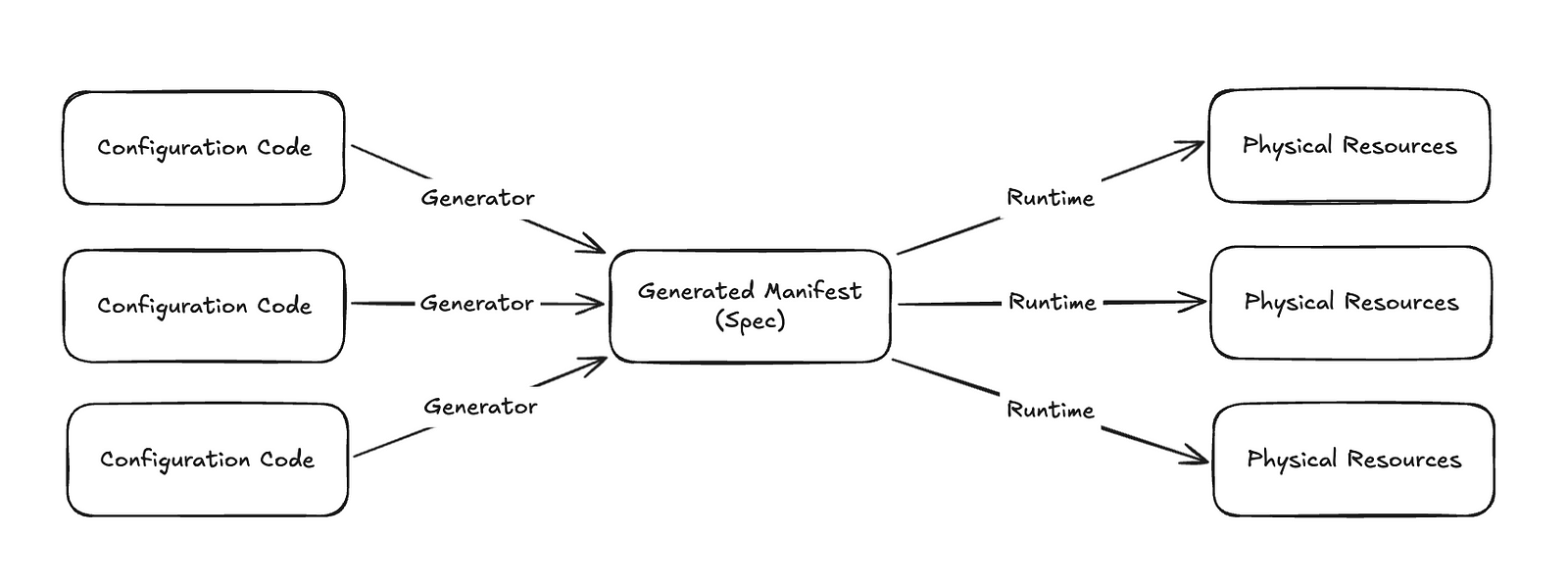Specs
The spec is a system-generated, immutable, declarative representation of the resources involved in a particular deployment. As opposed to the static configurations that are stored in a stack folder in a git repository, which may or may not be scoped to a given deploy target, a spec is dynamically rendered from the aggregated intents from multiple sources, including those that are target-specific, and those aren't (e.g. global configs, constraints posed by security, compliance and so on, for example what kind of application may have Internet access). Specs are resource-facing desired states and are always rendered on the spot based on all the relevant inputs.
The Specs are designed to be THE intermediate data layer between configuration code and actual resources. It is designed to be a structured data format that is both machine-friendly (so that we can use the proper libraries to process and actualize them) and human-friendly (so that it provides a readable reference to the resource perspective of an application).
Generators
The rendering logic that transforms the static configuration to the Spec are produced by "Generators", which are pieces of code written and distributed in Go. Generators are in charge of converting configuration code written in KCL into resource specifications in the Spec. They are packaged and wrapped inside a GRPC server whose lifecycle are dynamically managed as individual go-plugins.
Runtimes
In this workflow, the component that processes the resources in the Spec is called a Runtime. Runtimes are in charge of bridging the resource specification to the actual infrastructure API. For Kubernetes resources, its runtime uses client-go to connect to the clusters. For the cloud resources, we are using IAC tools like Terraform/Crossplane and their providers to connect to the cloud control APIs. Runtimes are also extensible.

Purpose of Spec
Single Source of Truth
In Kusion's workflow, the platform engineer builds Kusion modules and provides environment configurations, application developers choose Kusion modules they need and deploy operational intentions to an environment with related environment configurations. They can also input dynamic parameters like the container image when executing the kusion generate command. So the final operational intentions include configurations written by application developers, environment configurations and dynamic inputs. Due to this reason, we introduce Spec to represent the SSoT(Single Source of Truth) of Kusion. It is the result of kusion generate which contains all operational intentions from different sources.
Consistency
Delivering an application to different environments with identical configurations is a common practice, especially for applications that require scalable distribution. In such cases, an immutable configuration package is helpful. By utilizing the Spec, all configurations and changes are stored in a single file. As the Spec is the input of Kusion, it ensures consistency across different environments whenever you execute Kusion with the same Spec file.
Rollback and Disaster Recovery
The ability to roll back is crucial in reducing incident duration. Rolling back the system to a previously validated version is much faster compared to attempting to fix it during an outage. We regard a validated Spec as a snapshot of the system and recommend storing the Spec in a version control system like Git. This enables better change management practices and makes it simpler to roll back to previous versions if needed. In case of a failure or outage, having a validated Spec simplifies the rollback process, ensuring that the system can be quickly recovered.
Example
The API definition of the Spec structure in Kusion can be found here. Below is an example Spec file generated from the quickstart demo application (more details can be found here).
resources:
- id: v1:Namespace:quickstart
type: Kubernetes
attributes:
apiVersion: v1
kind: Namespace
metadata:
creationTimestamp: null
name: quickstart
spec: {}
status: {}
extensions:
GVK: /v1, Kind=Namespace
- id: apps/v1:Deployment:quickstart:quickstart-default-quickstart
type: Kubernetes
attributes:
apiVersion: apps/v1
kind: Deployment
metadata:
creationTimestamp: null
labels:
app.kubernetes.io/name: quickstart
app.kubernetes.io/part-of: quickstart
name: quickstart-default-quickstart
namespace: quickstart
spec:
selector:
matchLabels:
app.kubernetes.io/name: quickstart
app.kubernetes.io/part-of: quickstart
strategy: {}
template:
metadata:
creationTimestamp: null
labels:
app.kubernetes.io/name: quickstart
app.kubernetes.io/part-of: quickstart
spec:
containers:
- image: kusionstack/kusion-quickstart:latest
name: quickstart
resources: {}
status: {}
dependsOn:
- v1:Namespace:quickstart
- v1:Service:quickstart:quickstart-default-quickstart-private
extensions:
GVK: apps/v1, Kind=Deployment
- id: v1:Service:quickstart:quickstart-default-quickstart-private
type: Kubernetes
attributes:
apiVersion: v1
kind: Service
metadata:
creationTimestamp: null
labels:
app.kubernetes.io/name: quickstart
app.kubernetes.io/part-of: quickstart
name: quickstart-default-quickstart-private
namespace: quickstart
spec:
ports:
- name: quickstart-default-quickstart-private-8080-tcp
port: 8080
protocol: TCP
targetPort: 8080
selector:
app.kubernetes.io/name: quickstart
app.kubernetes.io/part-of: quickstart
type: ClusterIP
status:
loadBalancer: {}
dependsOn:
- v1:Namespace:quickstart
extensions:
GVK: /v1, Kind=Service
secretStore: null
context: {}
From the example above, we can see that the Spec contains a list of resources required by the application.
A resource is a concept in Kusion that abstract infrastructure. It represents an individual unit of infrastructure or application component managed by the Kusion, serving as a fundamental building block for defining the desired state of the infrastructure. They provide a unified way to define various types of resources, including Kubernetes objects and Terraform resources. Each resource in the Spec needs to have id, type, attributes, dependsOn, and extensions fields:
idis the unique key of this resource. An idiomatic way forKubernetesresources isapiVersion:kind:namespace:name, and forTerraformresources isproviderNamespace:providerName:resourceType:resourceName.typerepresents the type of runtime Kusion supports, and currently includesKubernetesandTerraform.attributesrepresents all specified attributes of this resource, basically the manifest and argument attributes for theKubernetesandTerraformresources.dependsOncontains all the other resources the resource depends on.extensionsspecifies the arbitrary metadata of the resource, where you can declare information such as Kubernetes GVK, Terraform provider, and imported resource id, etc.
Besides the resources, Spec also records the secretStore and context field in the corresponding workspace. The former can be used to access sensitive data stored in an external secrets manager, while the latter can be used to declare the workspace-level configurations such as Kubernetes kubeconfig file path or content, and Terraform providers' AK/SK. More information can be found here.
Apply with Spec File
When using the CLI, Kusion supports using the Spec file directly as input. Users can place the Spec file in the stack directory and execute kusion preview --spec-file spec.yaml and kusion apply --spec-file spec.yaml to preview and apply the resources.